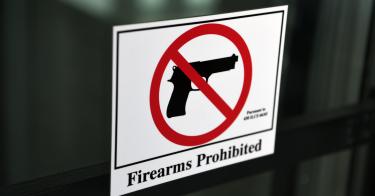After every high-profile mass shooting, gun control advocates reflexively demand that we “just do something” about the problem. Invariably, that “something” means a very specific set of things, which can be summarized as a singular effort to impose California’s restrictive gun laws at the federal level.
But did anyone bother asking whether California’s “cure” for mass shootings even works in California before peddling it to the nation?
California’s 39.2 million residents comprise 11.8% of the U.S. population. Yet, according to data from the Mother Jones Mass Shooting Database, the state accounts for 20% (17 of 85) of the nation’s mass shootings since 2012, and 16.1% of its mass shooting fatalities.
No other state comes close to bearing as much responsibility for mass shootings as California. In fact, the nation’s second most populous state—Texas—accounts for only 8.2% (7 of 85) mass shootings since 2012, and 14.3% of mass shooting fatalities, despite having a polar opposite approach to gun policy.
>>> Five Years After Parkland, Florida’s Measured Response Is an Outlier
While California’s government has spent the last 12 years imposing increasingly more restrictive gun-control measures on its residents, its mass shooting problem isn’t getting better. If anything, it’s getting slightly worse.
Between 2012 and 2017, 20% (8 of 40) of all mass public shooting incidents and 13.4% (48 of 358) of all mass public shooting fatalities occurred in California. From 2018 through mid-February 2023, the state was still responsible for 20% of all mass public shooting incidents, but its share of mass public shooting fatalities soared to a whopping 20.8% (58 of 279).
The Mother Jones database uses the more traditional definition of mass shooting, in which three or more people other than the shooter are killed in a public setting during an act of indiscriminate violence. There are, of course, other ways of defining a “mass shooting.” In recent years, the definition provided by the Gun Violence Archive—which lumps together any and all shootings in which at least four people are shot, regardless of the location or context—has been become the darling of gun-control advocates, who love to invoke its higher numbers as a scare tactic.
But clearly, those advocates are less interested in analyzing the underlying data.
While California certainly fares better under the broader definitions of mass shooting than it does under the more traditional definitions, the best that can be said is that, for all of the state’s gun laws, Californians are just as safe from mass shootings as Texans are. Between 2014 and Jan. 31, 2023, California accounted for 8.9% (363 of 4,040) of GVA-defined mass shootings, while Texas accounted for 6.7% (272 of 4,040). Given population differences, this leaves both states with a virtually identical rate of .92 mass shootings per 100,000 residents during that time period.
It's not just data from California and Texas that leaves Gun Control Inc. with a far more precarious argument than they care to admit.
Between 2019 and 2022, as just one example, A-minus-rated Illinois, Maryland and Connecticut had far higher mass shooting rates (2.11, 1.24, and .41 shootings per 100,000 residents, respectively) than F-rated states like Utah (.06), Maine (.07), New Hampshire (.07), West Virginia (.23) and Arizona (.39).
>>> Second Amendment Liberty’s Most Essential Safeguard 200 Years Later
But nothing could be as damning to the gun-control narrative on how to stop mass shootings as the reality experienced by the 2.7 million people living within the city limits of Chicago. At a state level, Illinois gun laws routinely rank among the most restrictive in the nation and receive an A-minus rating from Giffords. At a local level, Cook County—in which Chicago is located—has long imposed even more restrictions on residents, including a ban on so-called “assault weapons.”
And yet, according to the GVA data, this 228-square-mile area, holding less than 1% of the nation’s population, could properly be called the nation’s mass shooting capital. Between 2014 and Jan. 31, 2023, 7.8% (317 of 4,040) of all mass shootings and 7.9% (1,569 of 19,745) of mass shooting victimizations occurred in the Windy City. Shockingly, in seven of the nine years for which there is complete data, Chicago suffered more mass shootings than the entire state of Texas.
Meanwhile, Indiana—Chicago’s next-door neighbor whose less-restrictive gun laws are so often (and so unfairly) blamed for Chicago’s bloodshed—hasn’t been awash in the same violence. It accounts for 2.1% (84 of 4,040) of mass shootings and 2.1% (412 of 19,745) mass shooting victimizations between 2014 and Jan. 31, 2023, which in both cases is roughly equal to its proportion of the United States population.
It turns out that, for all of the indignant demands to “just do something,” gun control advocates keep feeding the nation snake-oil remedies that don’t do much of anything (except, of course, run roughshod on the Constitution).
There’s no spoonful of sugar big enough to make that medicine go down.
This piece originally appeared in MSN




